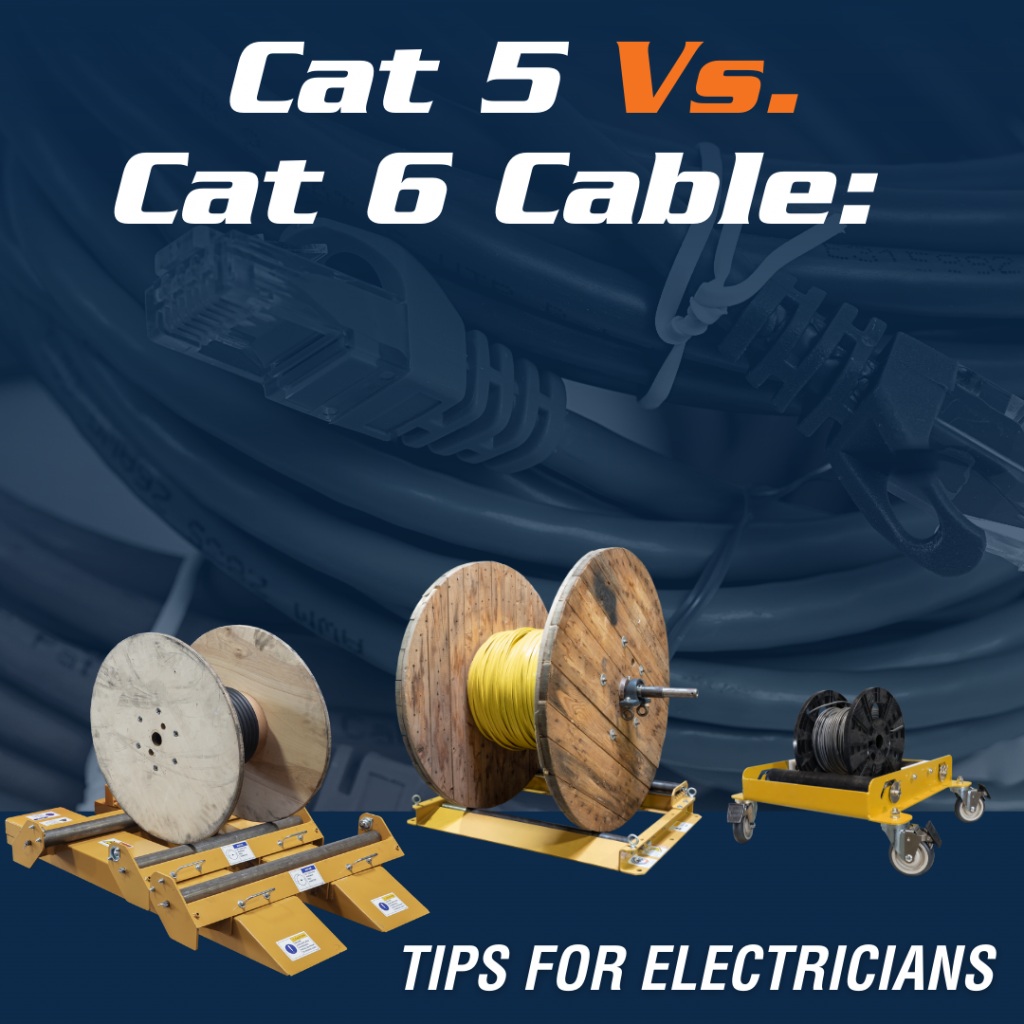We use cookies to make your experience better. To comply with the new e-Privacy directive, we need to ask for your consent to set the cookies. Learn more.
Cat 5 Vs. Cat 6 Cable: Tips for Electricians
Network cables can be tricky, particularly for industrial electricians. Cat 5, Cat 5e, and Cat 6 cables are essential, but cable spools are expensive; larger reels of network cables create vulnerabilities for material loss. Without appropriate reel handling equipment, installers might find themselves revisiting (and reinstalling) cable towards the end of a construction project. In this article, we’ll highlight several key considerations to help keep your next network cable installation on time and within budget.

Are Cat 5 Cables More Fragile Than Cat 6 Cables?
All network cables require a careful approach, but generally, Cat 6 cables are less susceptible to interference and more resilient to bending. However, there are several important factors to consider. Cat 6 cable has a higher twist rate than Cat 5 or Cat 5e, and standards call for additional shielding. Many Cat 6 manufacturers incorporate splines to isolate individual wires, which has the added benefit of preventing stretching.
Depending on the manufacturer, Cat 6 is more durable than Cat 5e, but in practice, material loss is common: Modern Cat 6 applications tend to require the cabling to perform at its full speed. In other words, if a customer is paying for Cat 6, they expect 10-gig performance.
A slightly damaged Cat 6 cable may pass a continuity check, but not a certification check. That can lead to frustrating situations for electricians. Many professionals will avoid enclosing the cable until after testing, but even with appropriate checks in place, Cat 6 cable can be tricky.
Cat 5 cable is also fragile when compared to other types of electrical cable, and the quality of the cabling can vary greatly from one manufacturer to the next. Cat 5 and Cat 5e are more susceptible to crosstalk than Cat 6, but the threshold for signal degradation might be higher depending on the application. Here’s the good news: For installers, Cat 5, Cat 5e, and Cat 6 cabling share the same basic characteristics. All of these standards have a bend radius of eight times the cable diameter (typically, about 1 inch, but some well-constructed Cat 6 cables have a bend radius of as little as 15 millimeters).
When Installing Networking Cable, Use the Right Material Handling Equipment
Cat 5e and Cat 6 cables can be dispensed straight from the spool, and on many worksites, that’s the standard process — but given the fragility of the cables, this practice can be expensive. Custom cable spool equipment can improve efficiency and manage costs, particularly on sites where multiple types of electrical cables need to be installed simultaneously.
BHS Reel Taxi™: Single-Spool Data Cable Management
Engineered for worry-free Cat 5/Cat 5e/Cat 6 cable management, the Reel Taxi has an adjustable reel roller platform to fit spool diameters from 12-24 inches. To prevent wire damage, the rollers are poly-coated and have sealed bearings to prevent slippage.
The Reel Taxi has four swivel casters and foot-activated brakes to keep the unit in place during payout. Poly pads on the frame interior provide additional protection. It’s an excellent solution for smaller cable installation tasks; for larger projects, consider the Dyna Reel Platform (DRP) or the forklift-attached Dyna Reel Platform Attachment.
BHS Wire Pull Carts: Simplified Wire Management for Networking Installation
The BHS Wire Pull Cart (WPC) is an all-steel unit with fully adjustable shafts for reels of virtually any size. PVC wire guides ensure a smooth pull, limiting chances of material loss when working with fragile cabling. The WPC is an especially useful option for installations that require multiple types of cabling: The shelves can be positioned as needed to accommodate different gauges, and four swivel casters allow for easy maneuverability.
The WPC also features steel doors with 180-degree hinges. The doors can be padlocked when not in use, protecting wires from theft and accidental damage. With lifting eye bolts and stock fork pockets, the Wire Pull Cart is ideal for greenfield installations.
At BHS, we understand that no two data cable jobs are the same, and we’ve engineered a variety of ergonomic solutions to address electricians' needs. All products can be customized upon request. For more information or to discuss specialized solutions for your operation, contact our sales team at 1.800.BHS.9500.
